PSPC and Office Space in Ottawa
Sorry, this one takes a while to get through. There is unfortunately no other way to explore these issues. This is not a 600-word article. There is a summary at the end for those in a rush. It won’t make as much sense if you skip over the middle bits.
Reach out to claim your prize if you get through it in one go.
Transparency? What do you mean?
Even for the folks at Public Services and Procurement Canada (PSPC), these are trying times when attempting to sort out the Government of Canada demand for office space in Ottawa. There was an opinion piece in the Ottawa Business Journal in which the commonly held feeling – why does everything with the federal government have to be so opaque – in reaction to what seemed to be another dribble of disconcerting news for how much office space PSPC expects to need from private sector landlords.
There is no magic insight into the beast that is the Government of Canada machinations for its office space game plan. One cannot even be sure there is a single source to ask to find that out. Despite that, maybe the following discussion makes things a little less opaque.
This is a summary of some of the issues they have pronounced on recently. Please keep in mind that most of these pronouncements were made at public forums like the Ottawa Real Estate Forum.
What have they have pronounced publicly:
There is no set order for the following points. How it all fits together is a conundrum/mystery. Mind you, it can feel like fitting together a jigsaw puzzle except that no one is sure what image is supposed to emerge.
Pronouncement 1: 80% of the office portfolio will be within a 600m walk of a rapid transit station.
This one we all know, and it makes a lot of sense. What we don`t know is do they mean a light rail transit (LRT) station, or an LRT station plus a bus station on a dedicated bus route (like in Gatineau or along Alta Vista Drive or eventually Baseline Road) and, does the LRT station need to exist already or can it be planned for delivery prior to their occupancy. To its credit the Government of Canada encourages its employees to use public transit, and it is now part and parcel of its net zero aspirations.
By the way, the Government of Canada owns a lot of office space in census metropolitan Ottawa (they call the National Capital Area (NCA)) area that currently does not meet this requirement. Any private landlord planning office construction inside this 600-metre requirement may be more favoured than they expect.
Pronouncement 2: the office portfolio will be spilt 75/25 between Greater Ottawa and Greater Gatineau.
We all know this one too. The Government of Canada adopted a policy by which at least 25% of its employees in the NCA will be housed in accommodations in Quebec. Their most recent commentary is that this ratio is good.
Pronouncement 3: PSPC is reconfiguring how they lay out office space to reduce their footprint.
We all know this one as well. Whether it is Workplace 2.0 or Activity-Based Workplace or GC Workplace, the Government of Canada is modifying how it makes office space available to its employees in order to optimise its use of space.
The resultant sea change this introduced to the office leasing market in Ottawa was the likelihood of renewals. Previously, it had been a pretty good underwriting assumption that once in occupancy PSPC would continue to renew, if only to make full economic use of the leasehold improvements they had paid for and installed in the premises. That way of thinking is now gone, as the existing leaseholds may no longer meet their needs. It switched from PSPC will most likely stay to PSPC will most likely leave.
The example PSPC gave goes like this: “Say we lease 10,000 square metres some place (they do everything in metric). On renewal and implementing our new workplace standards we don’t need 10,000 square metres, we only need 7,000 square metres. It is much easier to do 7,000 square metres in a new location than to attempt to retrofit in place and give up 3,000 square metres”.
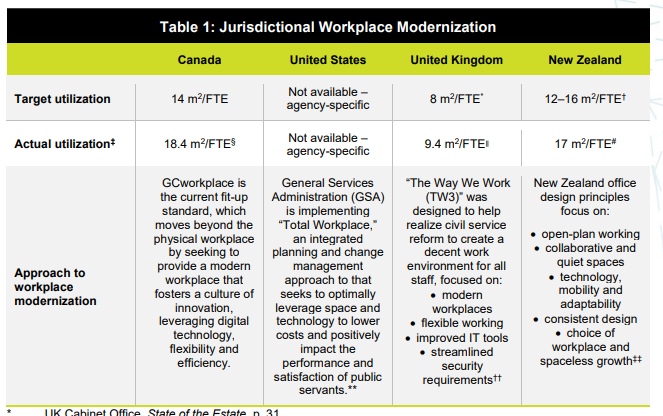
The implementation of GC Workplace means a reduction of about 30% in the footprint.
A second accelerant in that decrease in the size of the footprint is that there is still as gap in space utilization per employee (FTE=full time equivalent) between the actual – 18.4 square metres (200 square feet) – to the target – 14 square metres (150 square feet). That transition will mean a reduction in the footprint of 24%.
Pronouncement 4: leased office accommodations will be net zero by 2030.
This is in line with the Government of Canada’s efforts to combat climate change. This could be one of the PSPC “contributions” to this government policy initiative. Similarly, the implementation of Workplace 2.0 was the PSPC “contribution” to the Deficit Reduction Action Plan (DRAP) of the early 2010s.
This one will be tough to implement seeing as there are few, if any, net zero office buildings in Ottawa now. If it needs to be delivered by 2030, they better start that project right away.
Pronouncement 5: various minimum specs for leased space.
PSPC has adopted a stance that it will lead the nation in improving the quality of the office space it occupies. That includes access and building performance measures amongst others. This is apparent in their recent tender calls for office space as they value LEED Silver (existing buildings) or LEED Gold (new buildings) as well as BOMA and other standards for building performance. Other examples include that no employee at a workstation should be more than 12 m (40 feet) from natural light, and their requirements for accessibility in all premises.
Pronouncement 6: Our portfolio of office space will be 50/50 owned versus leased.
This pronouncement changes occasionally. For a long time PSPC aimed to be about 50% owned and 50% leased. In the early 2010 it was 45% owned and 55% leased, and now it has changed back.
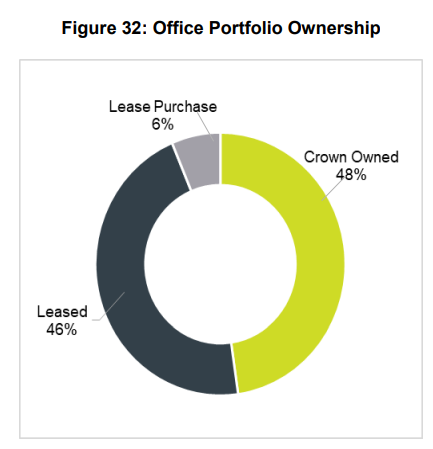
A little Government of Canada in the NCA context helps:
This is where context and (unfortunately) government operations help in sorting stuff out.
The following chart is a breakdown of the Government of Canada inventory of office space.
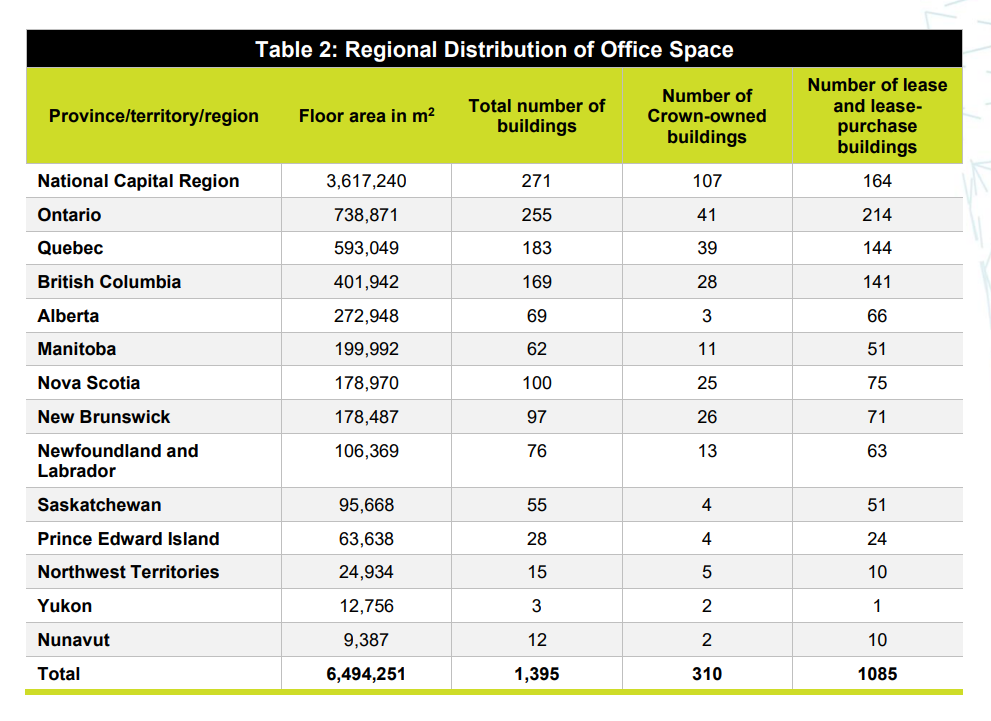
TBS lists 404 office buildings with a total floor area of 4,459,293 square metres (48,000,000 square feet) in its portfolio in the NCA. The first nuance is that not all these buildings are the responsibility of PSPC. The PSPC portfolio is 236 buildings comprising 38,710,000 square feet. Some are the responsibility (“custody”) of other departments like National Defence.
The phrase that PSPC uses is that they are “custodian” for office space for about 100 departments and agencies in Ottawa. Being custodian means they get the budget allocation for paying for owned and leased office accommodations for all these departments and agencies. PSPC is the party signing the leases and paying the rent; the client departments occupy the premises; and PSPC gets to manage most office space use in the NCA.
What they tell us:
Demand for office space from PSPC in Ottawa is driven by the needs of its 100-odd client departments and agencies. PSPC responds to changes in the scope of a department’s operations, or a merger of departments, or take the expiry of a lease to look to implement its new design standards. It takes time for PSPC to secure a mandate to go to market for a renewal or search for new accommodations. PSPC does this about 100 times a year in the NCA.
The unfortunate part is that departments can’t really do any longer-term planning for space requirements, and that hampers PSPC leasing efforts to optimise its office space portfolio. The departments with lease expiries during the pandemic were willing to give the space up as they did not know how work from home would affect longer-term demand. PSPC said if the space is less than 5,000 square metres, expect the occupant to give up the space. The client departments would look to centralise their employees in the building in which that department considered to be its headquarters or in other larger space and give up some satellite locations.
PSPC has reached out to the private landlord community to investigate how it might get to a leased office portfolio that has net zero buildings by 2030. PSPC is realizing that given the costs necessary to get to that criterion, it may not make sense for the owner to make that investment in their building in which PSPC occupies 20% or 30% or 40% of the building. PSPC may concentrate on buildings where they are the sole occupant as (maybe) then the math for the conversion costs works better for the owner for their unique requirement. As a corollary, they may migrate from building where they are one of many occupants to buildings in which they are the sole occupant.
What is hard to find out and verify:
TBS commissioned a study of the management of fixed assets by all government departments as it suspected there was room for improvement in asset management. That study was commissioned in 2016 and the report, the Treasury Board Horizontal Fixed Asset Review, was finalized in 2019. It was released to the public in 2021.
One of the interesting charts from that report is reproduced below:
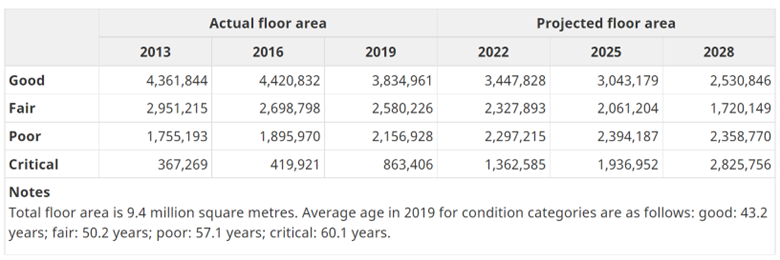
There is a quickly approaching wall of 30.4 million square feet office buildings in critical condition they occupy by 2028. The PSPC office portfolio has 25 buildings with a total floor area of 4,600,000 square feet in “critical” condition in the NCA.
It is hard to find this report: most people don’t know it exists. Even so, this a summary for the Government of Canada, not necessarily just PSPC, and then as well it is a national total and not just the NCA. There is another report – the Office Long Term Plan – that was completed during the pandemic that may eventually be available to the public to review. They are currently updating it, presumably to reflect the increase in work from home activities by employees.
Another difficulty is to determine is just how many employees the Government of Canada has in the NCA. TBS does publish the population of the federal public service.
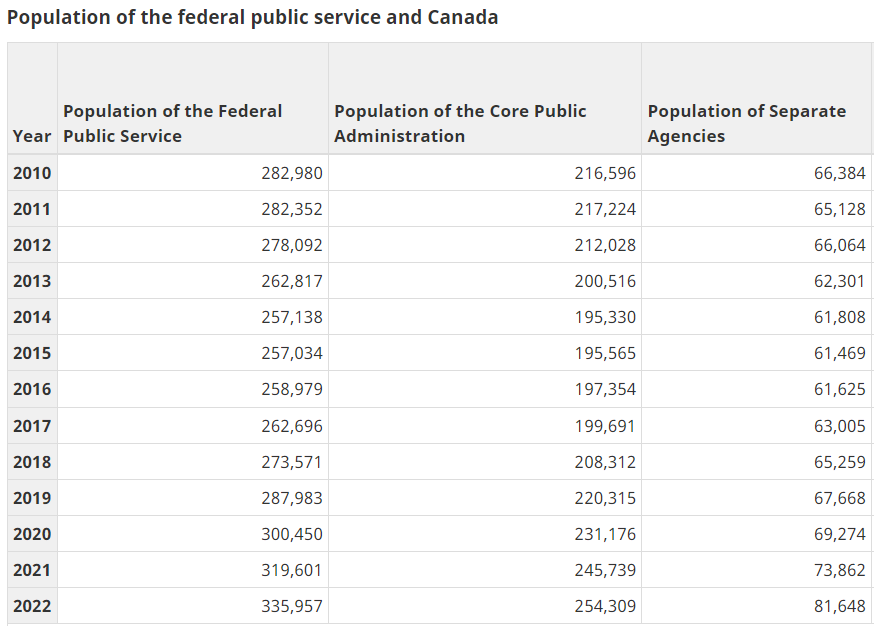
Keep in mind there are about 150,000 federal civil servants in Ottawa. TBS excludes National Defence and the RCMP employees from this summary, so it Is hard to tell. The last number I saw had National Defence with 15,000 employees in the NCA with perhaps 9,000 in the headquarters at Moodie and Carling. What Treasury Board excludes above could be a meaningful quantum of potential office space demand.
The federal government workforce has grown by 48,000 since 2019. Assuming ½ of that growth is in the NCA, that means another 24,000 people employed here. For that 24,000-person increase, GC Workplace provides 7 workstations for every 10 employees. That means a requirement for 16,800 workstations.
Solving for the potential increase in demand for office space is 16,800 workstations needing 14 square metres per employee (now workstation) means there needs to be 2,530,000 square feet someplace housing these workstations for the new hires.
PSPC office portfolio performance metrics
This offers insight into the metrics used by PSPC in reporting the efficiency of its occupancy of its office portfolio. This report is circa 2019.
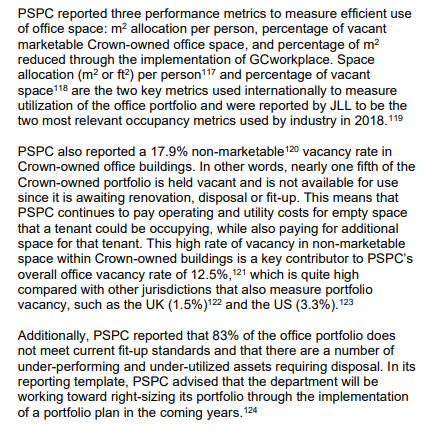
Assuming the percentages above are representative of the NCA portfolio:
- Crown-owned non-marketable vacant space is 3,840,000 square feet in its portfolio of 99 buildings comprising 21,450,000 square feet;
- the lease and lease-purchase portfolio is 137 buildings comprising 17,260,000 square feet;
- the overall portfolio vacant space is 4,840,000 square feet; and,
- that implies that the leased and lease-purchase portfolio has a vacancy rate of 5.8% and 1,000,000 square feet unoccupied.
What was hidden to the landlord community here is just how big a part of the PSPC portfolio was “non-marketable” owned office space. The portion of vacant space they experienced, the 5.8% in the leased portfolio, could be hard to determine as well.
That means there is a potential reduction to the PSPC footprint by disposing of properties with non-marketable vacant space, and that is about 10% of the PSPC office portfolio in the NCA.
The recent big shocker:
This news story ran May 30, 2023:
The federal government is planning to offload up to half of its office buildings across the country, citing the rise in remote and hybrid work.
Deputy Minister of Public Services and Procurement (PSPC) Paul Thompson made the comment at the Standing Committee on Government Operations and Estimates Monday.
“We see an opportunity for a fairly significant reduction in the coming years of the office space,” he said.
“Our previous target was to reduce the portfolio by 40 per cent. We now think we can reduce it closer to 50 per cent as a target.”
As reported by Ted Raymond, CTV News amongst others
Doing the math on the impact of office space demand in the NCA
- GC Workplace implementation reduces their requirement for space by about 30%;
- GC Workplace standards have been implemented in about 20% of the PSPC portfolio;
- Reducing actual space utilization per employee to the target allocation is a reduction of 24% in demand;
- PSPC has 25 buildings comprising 4,600,000 square feet that is in critical condition;
- Crown-owned non-marketable office space is 17.9%. There is close to 4,000,000 square feet they own and can’t occupy. This is about 10% of the PSPC office portfolio in the NCA; and,
- New hires since 2019 constitute demand for 2,530,000 square feet for their GC Workplace premises.
The “big shocker” feels more like an update to all of us following their market activity, as opposed to a comment that came out of no place. The answer was hiding in plain sight all along. The ADM of PSPC Real Property did everyone’s math homework and told us about it.
Transparency?
Absolutely agreed, it is hard work to follow what PSPC is doing here. It takes a commitment to piece together what they plan to do and how they will do it, especially for the longer hold periods that office investments (equity and debt) require.
TBS and PSPC have reports they make available on the web site as all the charts and clippings above indicate. They exist, and if you know what they are called, where to find them, and persevere in finding them, you can conduct the due diligence that supports making investments in real estate. Unfortunately, the information published is usually pretty dated by the time you find them and alert others to their existence.
How about you? Any suggestions for ways to make it easier for the private sector to better understand what PSPC is doing in the office leasing market in the NCA?
